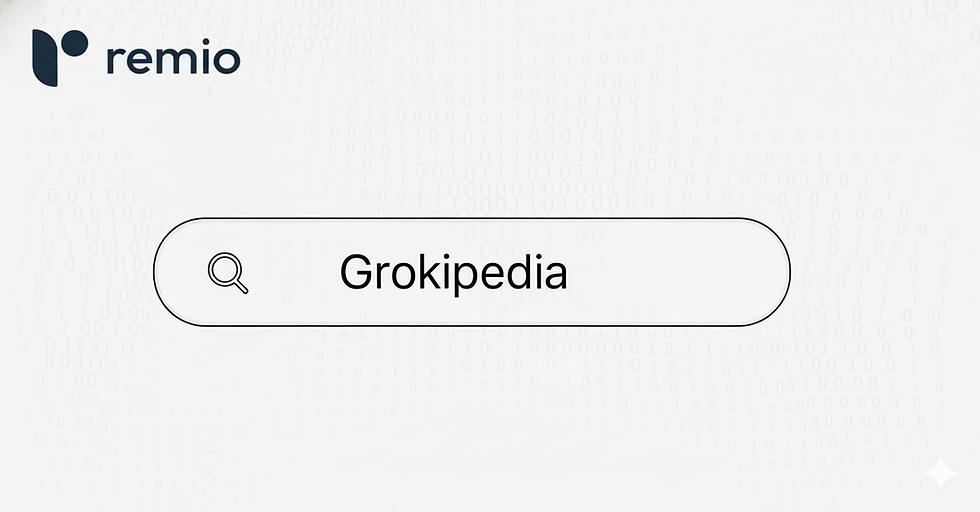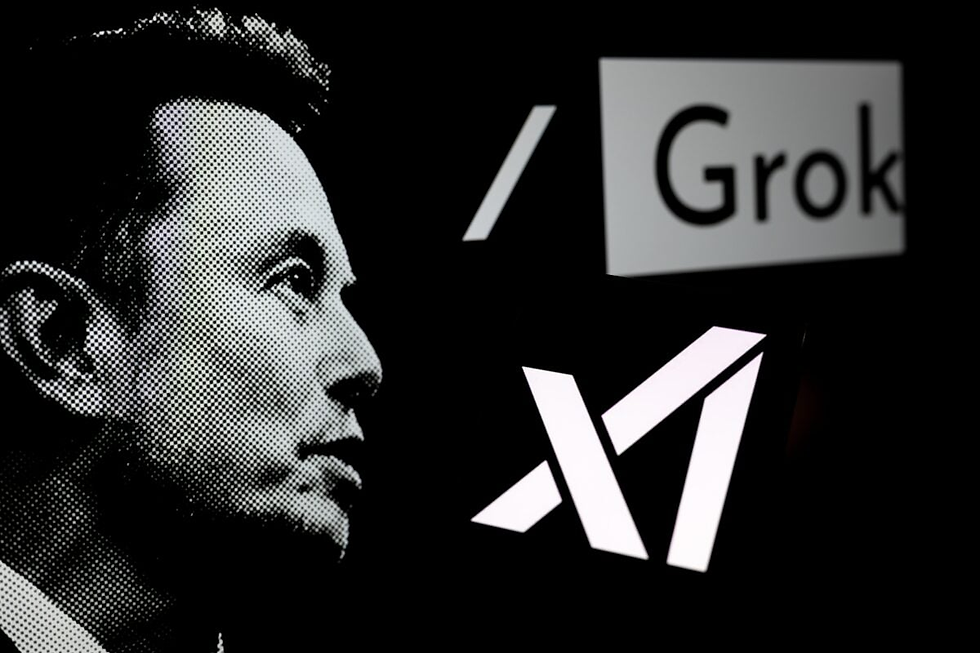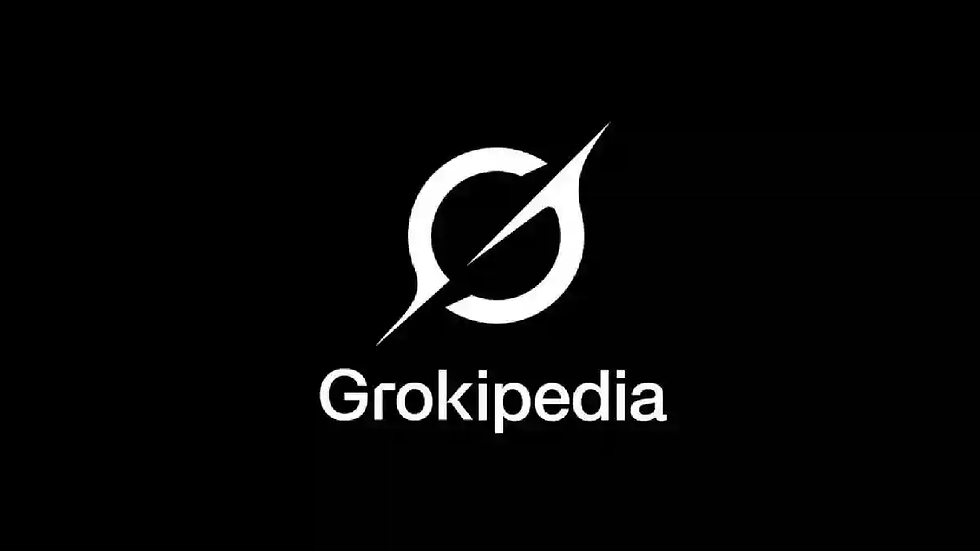Elon Musk Says xAI Is Building ‘Grokipedia’, an AI-Powered Rival to Wikipedia
- Olivia Johnson

- Oct 6
- 11 min read

What Grokipedia is and why this launch matters
Quick summary and the stakes behind Grokipedia
Elon Musk’s xAI has announced a new project called Grokipedia, an AI-driven encyclopedia that the company positions as a direct rival to Wikipedia. xAI confirmed that a “version 0.1” of Grokipedia is coming soon, and public statements from Musk framed it as a “massive improvement” over existing encyclopedias. The announcement followed a broader set of product developments around Grok and the Grok-4 model family, signaling that xAI is moving from critique to concrete engineering rather than merely issuing a conceptual rebuke of Wikipedia’s editorial approach. Those comments and the launch signal were summarized in a brief announcement report.
Why this matters now is twofold. First, the source is direct: Musk and xAI are not merely opining about the state of reference content — they are building software to supplant or complement it. Second, the timing links product development (Grok/Grok-4) to a public-facing knowledge project, suggesting a roadmap where large language models (LLMs) power a full-stack reference experience. That combination elevates Grokipedia from rhetoric to something that could meaningfully alter how the public looks up facts and narratives.
Practical implications for everyday readers
For users, Grokipedia promises a different experience: instant, model-synthesized entries that may read like conversational summaries, plus integrated citations or links in ways traditional encyclopedias don’t currently deliver via chat-style interfaces. If xAI achieves accurate, attributed passages, Grokipedia could make quick research and casual fact-checking faster. But important unknowns remain: the release date, whether there will be free access or subscriptions, and — critically — how xAI will handle moderation, provenance, and regulatory compliance. Early coverage framed the initiative as a response to perceived bias in Wikipedia, which shifts the conversation from technical novelty to cultural and editorial norms. See reporting that frames Grokipedia as a response to alleged bias on Wikipedia for more context on the motivation behind the project.
Insight: An AI-first encyclopedia changes the trade-offs — speed and personalization for a new set of verification and transparency requirements.
Key takeaway: Grokipedia is an explicitly engineered alternative to Wikipedia backed by xAI’s Grok model lineage — concrete, imminent, and worth watching for how it balances speed with trust.
Grokipedia features: how xAI says it will work

AI-native content generation and the promise of synthesis
xAI describes Grokipedia as an encyclopedia “powered by AI” that will synthesize knowledge using its Grok family models instead of relying solely on volunteer edits. That model-native approach means entries could be generated in real time, crafted to answer a user’s specific query, and adapted to different reading levels or contexts. The idea is not merely to regurgitate existing pages but to produce concise, synthesized narratives that combine multiple sources and offer an immediate answer. Early press coverage emphasized the AI-first angle as Grokipedia’s defining feature.
Define: Large language model (LLM) — a machine learning model trained on vast text corpora to predict and generate natural language. LLMs can synthesize information but may produce incorrect statements without proper safeguards (“hallucinations”).
Bias, neutrality and editorial stance
One of xAI’s stated goals is to address what Musk calls Wikipedia’s “hopelessly biased” content. That frames Grokipedia as a corrective that will use algorithmic curation and source prioritization to reframe neutrality. But algorithmic neutrality is a contested and technical concept: bias can enter via training data, ranking systems, or editorial rules. xAI’s pitch reframes neutrality from a community-driven consensus to a model-driven balance based on chosen sources and weighting strategies. Coverage of the announcement emphasized this motivation and the debate it raises about neutrality in encyclopedias (Times of India framed xAI’s comments as a critique of Wikipedia bias).
Key takeaway: Grokipedia’s neutrality will be shaped less by edit history and more by source selection and model behavior — a fundamental shift that requires transparent policies to gain trust.
Expected user-facing features and verification tooling
Based on xAI’s positioning and the known capabilities of Grok/Grok-4, practical features likely include instant summarized entries, conversational Q&A layered over encyclopedic content, and AI-assisted citations or link-generation. The company has hinted at integrated verification tools; these would be essential to keep model outputs grounded in primary sources and to reduce hallucinations. Reporting on Grok-4’s capabilities suggests xAI is working on performance and physicist-grade model ambitions, which could translate into domain-aware retrieval and citation mechanics in Grokipedia.
Anticipated editorial tooling might include provenance tagging (linking sentences to sources), confidence scores, and human-in-the-loop review interfaces for disputed topics. Those mechanisms are not confirmed but are standard mitigations for hallucination-prone models.
Insight: If Grokipedia pairs conversational answers with explicit source links, it could combine the convenience of chatbots with the traceability of footnotes — but only if those links are reliable and auditable.
Grokipedia specs, performance and rollout plans
Versioning, timeline and model clues
xAI has publicly stated that a Grokipedia “version 0.1” is “coming soon,” which signals an early-stage launch likely to be an invite-only or limited-scope rollout rather than a complete encyclopedia replacement on day one. Livemint summarized that version 0.1 remark and outlined the expected early-release cadence. Given the pattern of other AI rollouts, version numbers this low typically indicate alpha/beta iterations focused on narrow domains, UI testing, and feedback loops before broader distribution.
Clues about the underlying model come from xAI’s Grok family and public statements that situate Grok-4 as a high-performance model. Tom’s Guide covered Grok-4’s release and hinted at the model’s intended professional and scientific use cases. It’s reasonable to infer that Grokipedia will use Grok-4 class models or variants optimized for factual retrieval and source attribution, likely combined with retrieval-augmented generation (RAG) architectures that attach external text and citations to model outputs.
Define: Retrieval-augmented generation (RAG) — a technique where an LLM queries a curated database or the web for source passages and uses those passages to ground its generated answers, improving factual accuracy.
Performance expectations and infrastructure needs
xAI claims Grokipedia will be a “massive improvement” in speed and synthesis over existing encyclopedias, but specifics like latency, retrieval accuracy, and dataset refresh cadence have not been published. Independent observers note that to match Wikipedia’s breadth and depth, Grokipedia will need substantial compute, fast indexation of primary sources, and continuous retraining or refresh pipelines. Benzinga highlighted the “massive improvement” framing in coverage of Musk’s comments.
Operationally, delivering high-quality, up-to-date entries requires both scale and careful engineering: a dense vector index for retrieval, frequent source crawling, provenance tracking, and human moderation channels to resolve disputes. Those are non-trivial engineering challenges that drive cost and complexity.
Rollout, eligibility and pricing signals
The public messaging points to a staged rollout: developer previews, researcher access, and invite-driven consumer tests before a broad launch. UPI’s announcement coverage placed the project in the “coming soon” window. Pricing is unknown. Market logic suggests a mixed model: free consumer access to attract readers paired with paid enterprise APIs or premium features for developers and organizations. xAI’s commercial posture and precedent among AI companies make that scenario plausible.
Regulatory considerations could influence rollout timing and geographic availability. Some countries may require disclosure of AI-generated content, provenance information, or even specific moderation rules before permitting full public deployment, which would shape how and where Grokipedia first appears (Economic Times noted policy and regulatory constraints that could affect launch plans).
Key takeaway: Expect an incremental release that emphasizes technical validation and regulatory compliance, with pricing and broad availability decided after early testing and policy review.
How Grokipedia stacks up against Wikipedia and other alternatives

Core differences in curation and editorial model
The most fundamental contrast is method: Grokipedia is being planned as an AI-synthesized encyclopedia, while Wikipedia is a human-curated, volunteer-edited knowledge base with versioned pages and community governance. Wikipedia’s strength is its transparent edit history and citation trail; every claim can be traced to a revision and talk-page discussion. Grokipedia’s potential strength is rapid synthesis, personalized responses, and the ability to aggregate and summarize across many sources within seconds. But that speed replaces — rather than mirrors — the distributed, deliberative process that produces many of Wikipedia’s checks and balances. Coverage that highlights this strategic positioning frames Grokipedia as deliberately engineered to address alleged bias and latency issues in human-edited encyclopedias.
Speed, freshness and verifiability trade-offs
Grokipedia promises faster, on-demand synthesis and could offer more frequent content updates if it builds a real-time retrieval backbone. That contrasts with Wikipedia’s update cadence, which is human-paced and can be slowed by edit wars and consensus building. The trade-off is verifiability: Wikipedia’s human edit trail and sourcing provide institutional trust even when individual pages are imperfect. Grokipedia must provide equivalent or better provenance mechanisms (clear, clickable source links, time-stamped citations, and audit logs) to be trusted for the kinds of high-stakes references that academics, journalists, and institutions rely upon.
Insight: Speed without robust provenance is convenience masquerading as reliability.
Competitive positioning and likely market impact
xAI positions Grokipedia as a “massive improvement,” but actual market impact will depend on several factors: the accuracy of model outputs, transparency of sources, editorial moderation, and how quickly regulators apply disclosure rules to AI-generated public content. Some scenarios are plausible: Grokipedia could become the default place for quick, factual answers and conversational queries, while Wikipedia remains the go-to archival and citation workhorse for academic and legal contexts. Alternatively, if Grokipedia nails provenance and builds trust, it could capture a broad slice of casual research traffic and even prompt new standards for reference citation.
Industry observers noted both the ambition and the unknowns: creating a trusted, large-scale knowledge base is as much a social and governance task as it is an engineering one (Benzinga discussed the market implications of xAI’s claim).
Key takeaway: Grokipedia’s competitive edge will come from combining rapid synthesis with auditable sourcing; absent that, Wikipedia’s social infrastructure remains a major advantage.
Who benefits from Grokipedia and what policy challenges it faces

End users, developers and institutions that could gain
Consumers could benefit immediately from crisp, conversational summaries and faster access to synthesized context for everyday questions. Developers and researchers may find value in API access or structured exports that let them integrate Grokipedia’s outputs into applications, chatbots, and analytics tools — a shift away from reliance on static Wikipedia database dumps toward dynamic, API-driven knowledge endpoints. Aibase noted the potential developer interest in new AI-driven knowledge sources.
Institutions — universities, media organizations, and enterprises — will evaluate Grokipedia based on accuracy and auditability. If xAI offers clear provenance and licensing terms, those organizations might adopt Grokipedia for internal knowledge bases or as a supplementary verification layer. But adoption will be conservative until Grokipedia demonstrates consistent, transparent sourcing.
Community impact and new contributor roles
Grokipedia could create fresh roles in the knowledge ecosystem: AI fact-checkers, provenance auditors, and human-in-the-loop moderators who verify model suggestions and correct errors. That could attract professionals who want salaried, accountable positions rather than volunteer-driven contributions. However, it could also displace or demobilize volunteer communities unless xAI fosters collaborative tooling that allows volunteers to inspect and influence outputs.
Accuracy, bias, regulation and trust hurdles
A major challenge is accuracy: LLMs can produce confident-sounding but incorrect outputs (so-called “hallucinations”), and scaling a generative system to global, multilingual coverage increases risk. Grokipedia will need strong RAG pipelines, transparent source attribution, and human review workflows to reduce hallucination risk. Tom’s Guide discussed expectations around Grok-4’s capabilities that inform these technical mitigations.
Bias and neutrality remain thorny. Algorithmic neutrality depends on training data selection, source prioritization, and model prompts — all choices that must be made explicit for outside scrutiny. Policymakers are already considering disclosure and provenance requirements for AI-generated content, and those rules could shape Grokipedia’s features and launch windows. Economic Times covered the policy contours that could affect Grokipedia’s debut.
Trust is the final arbiter. Without transparent ways to trace a claim back to primary materials and an independent auditing mechanism, institutions will be cautious about replacing human-curated sources with AI-synthesized ones.
Insight: Technical prowess alone won’t win trust — governance, transparency, and legal clarity will.
Key takeaway: Grokipedia could create valuable tools and roles, but overcoming hallucinations, bias, and regulatory uncertainty will determine whether it becomes a professional-grade reference or remains a convenience product.
Grokipedia FAQ

Is Grokipedia available now? (Grokipedia availability)
Short answer: No. xAI has announced Grokipedia and said version 0.1 is “coming soon”. Expect staged releases such as invites or developer previews before broad public access.
What to watch for: xAI blog posts, sign-up pages for early access, and invitations to developer or researcher previews will be the usual signals that public availability is expanding.
How will Grokipedia handle accuracy and sources? (Grokipedia accuracy and sourcing)
Short answer: xAI says it intends improvements, but specific mechanisms are not publicly detailed. The company is likely to use retrieval-augmented generation (RAG) and source-linking to ground model outputs, with human-in-the-loop verification for sensitive topics.
Practical note: Look for explicit provenance (clickable citations tied to text), confidence indicators, and a visible corrections process before relying on Grokipedia for high-stakes work. Reporting on Grok-4’s intended use cases suggests these are plausible mitigation strategies (Tom’s Guide on Grok-4 context).
Will Grokipedia replace Wikipedia? (Grokipedia vs Wikipedia replacement question)
Short answer: Unclear. xAI and Musk claim a “massive improvement,” but replacement depends on trust, verifiability, community adoption, and regulatory acceptance.
Real-world outcome: A spectrum of possibilities exists — Grokipedia could coexist with Wikipedia, serve as a faster Q&A layer, or partially supplant certain use cases if it proves consistently reliable. Analysts emphasize that social governance and provenance are as important as technical speed in defining real replacement potential (Benzinga’s coverage of the claim and market outlook).
Will Grokipedia be free to use? (Grokipedia cost and pricing)
Short answer: Not announced. xAI has not disclosed pricing details; options range from a free consumer tier to paid APIs or premium features for enterprises.
What to expect: Many AI products launch with free access to build user bases, then layer paid features or API quotas for developers. Until xAI publishes terms, assume a mixed model is plausible (Livemint captured the early-launch posture).
How will Grokipedia be regulated? (Grokipedia regulation and policy)
Short answer: It will operate amid evolving rules. Regulators worldwide are debating disclosure, provenance, and liability rules for AI-generated content, and those policies may affect where and how Grokipedia launches.
Key risks: Regional compliance demands could require labeling AI-generated passages, audit logs, or even limit certain categories of content until verified. Expect incremental rollouts tied to policy readiness in target markets (Economic Times on regulatory considerations).
Can developers integrate Grokipedia content? (Grokipedia developer access)
Short answer: No official API has been announced yet, but xAI’s product posture and market dynamics make developer APIs a plausible future offering.
Developer implications: If an API is provided, it could change the landscape for knowledge-based apps by offering dynamic, synthesized knowledge endpoints rather than static dumps — however, licensing terms and rate limits will shape adoption and integration potential (Aibase discussed potential developer interest in AI knowledge platforms).
Looking ahead: what Grokipedia could mean for public knowledge
Near-term expectations and longer-term possibilities
Grokipedia signals a concrete attempt to build an AI-first encyclopedia that could change how people get summarized, sourced answers. In the coming months, expect a careful, staged rollout (version 0.1 as an alpha), public scrutiny around bias and provenance, and active debate over whether AI or humans should arbitrate contested facts. Watch for xAI to publish more specific governance documents: source-selection policies, correction workflows, and how human reviewers will intervene.
If Grokipedia proves reliable and transparent, the long-term implications are significant. It could accelerate AI adoption in knowledge work, prompt new citation norms that blend model outputs and source links, and spawn hybrid editorial models where AI drafts and humans validate. Educational institutions might adopt Grokipedia for quick overviews while insisting on primary-source citations for formal work. Developers could build new classes of research assistants that combine Grokipedia’s synthesis with domain-specific verification layers.
But uncertainties and trade-offs remain. Algorithmic neutrality is not the same as editorial neutrality; choices about which sources to prioritize will reflect explicit values. Regulatory frameworks could impose constraints that reshape features or limit launch geographies. And public trust will be hard-won — the product must demonstrate transparency and accuracy at scale before replacing human-curated references.
Insight: The most likely near-term outcome is coexistence — Grokipedia as a high-speed companion to Wikipedia’s archival, community-driven authority — with the longer-term shape decided by governance, not just technology.
For readers and organizations, this is an invitation to prepare. Libraries, schools, and newsrooms should start experimenting with AI-curated summaries while retaining strict verification standards. Developers should monitor early API announcements and think about how provenance and licensing will affect product design. And citizens should demand clear provenance for any AI-synthesized facts they rely on.
Key takeaway: Grokipedia could reshape access to factual summaries and research, but its real influence will depend on transparency, governance, and whether it can match Wikipedia’s hard-earned trust with equally rigorous attribution.

